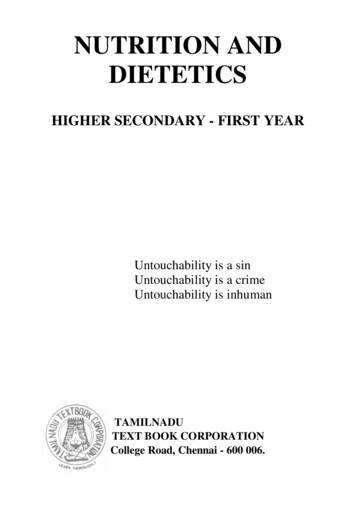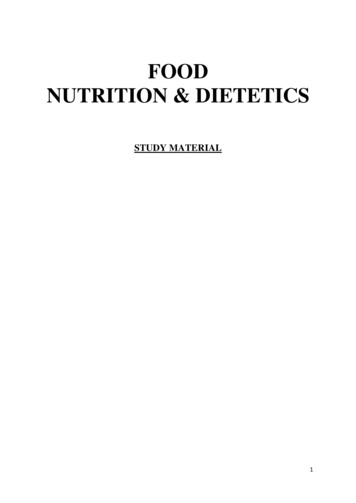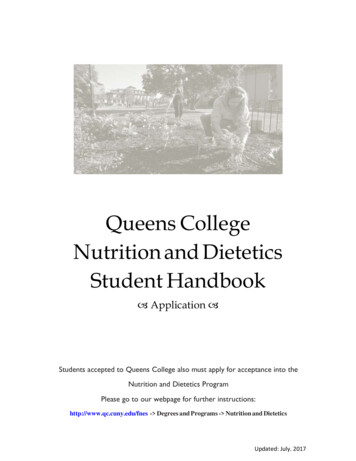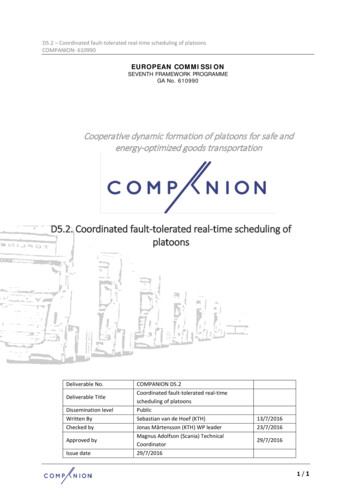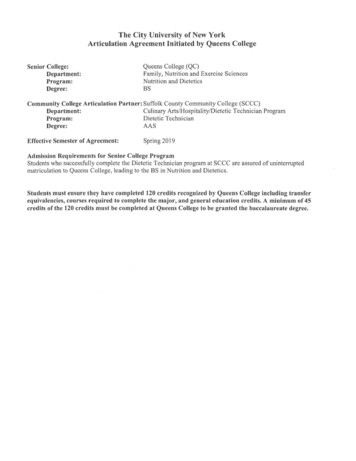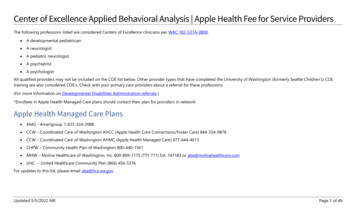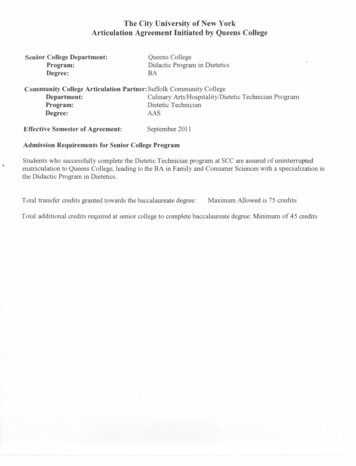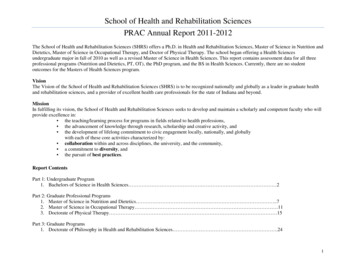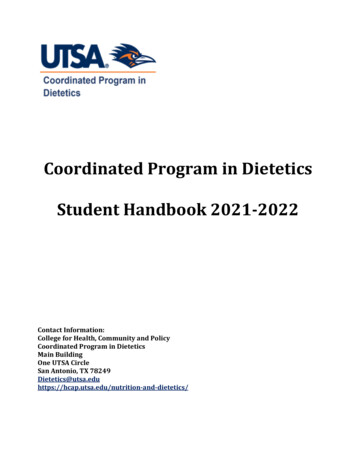
Transcription
Coordinated Program in DieteticsStudent Handbook 2021-2022Contact Information:College for Health, Community and PolicyCoordinated Program in DieteticsMain BuildingOne UTSA CircleSan Antonio, TX tion-and-dietetics/
ContentsCOORDINATED PROGRAM IN DIETETICS . 4INTRODUCTION . 4UTSA’s Mission and Core Values . 4Program History . 4Program Status. 5The Profession of Dietetics . 6CPD Mission . 6Program Description. 6Admission Options . 7Admission Criteria . 8RD/RDN Exam Statistics. 10Academic Calendar and Scheduling . 11Course Sequence Overview . 12Tuition and Program Cost . 13Program Related Expenses . 14Tuition and Fees . 14Financial Aid. 15Support Services. 15Protection of Privacy . 16Official Communication . 17Orientation . 19Advising . 19Program Requirements. 19Immunizations Required by the Program . 19Student Safety and Risk Acknowledgement. 20Student Health Insurance . 20Criminal History and Drug Testing Policy . 21Drug Testing Policy . 22Employment While in the Program . 22Professional Expectations . 23Attendance, Absences and Tardiness . 23Class and Practicum/Internship Policy:. 232
Medical or Emergency Leave . 24Attendance to Professional Meetings. 25Academic Accommodations for Religious Beliefs . 26Standards of Professional Behavior for Dietetic Students . 26Academic Expectations . 26Practicum Demands . 26Professionalism . 27Dress Code . 27Code of Ethics for the Profession of Dietetics . 28Student Performance Evaluation . 29Student Fitness to Practice Policy. 31Student Progress and Advancement . 32Program Complaints . 34Faculty Academic Review (FAR) Committee. 35Program Evaluation by the Students . 36Facility Affiliations . 36Graduation. 36Requirements for Students to Receive Verification Statement . 37Verification Statement for Eligibility for the Registration Exam . 37Privacy and Confidentiality . 38UTSA Administrative Policies and Procedures. 40Nondiscrimination and Sexual Harassment and Sexual Misconduct . 40Inclusion and Community Engagement . 41Organization Membership . 41Research Assistant Position Guidelines . 42Student Volunteer Guidelines . 423
COORDINATED PROGRAM IN DIETETICSINTRODUCTIONWelcome and congratulations on selecting the field of dietetics for your future career!This handbook is designed to guide enrolled students on issues related to the Coordinated Program inDietetics (CPD). The information, as well as the policies and procedures are in accordance with thoseof the University of Texas at San Antonio, the College for Health, Community and Policy and theAccreditation Council for Education in Nutrition and Dietetics (ACEND) Standards.The information presented on this handbook will supplement information in the UniversityCatalog. The University Catalog (http://www.utsa.edu/ucat/index.html) contains policies andregulations pertaining to admission, progression, grading, and curriculum. Students should befamiliar with the information in this CPD Handbook, the University Catalog, and Online UTSAStudent Handbook ing/catalogs/.Additional guidelines and policies will be added as needed and distributed as they are finalized.Changes in policy will take effect on notification, unless otherwise noted. Students are expectedto follow all Program, College, and University policies and requirements. Failure to meet anypolicy, guideline, rule, regulation, or law may result in disciplinary review or dismissal.UTSA’s Mission and Core ValuesThe University of Texas at San Antonio is dedicated to the advancement of knowledge throughresearch and discovery, teaching and learning, community engagement and public service. As aninstitution of access and excellence, UTSA embraces multicultural traditions and serves as a centerfor intellectual and creative resources as well as a catalyst for Socio-economic development andthe commercialization of intellectual property for Texas, the nation and the world. UTSAencourages an environment of dialogue and discovery, where integrity, excellence, inclusiveness,respect, collaboration and innovation are fostered.Program HistoryOn January 29, 2009, the Texas Higher Education Board authorized the University of Texas HealthScience Center to create a Bachelor of Science degree with a major in Dietetics and Nutrition anda Master of Dietetics Studies. Following this authorization, the Commission on Accreditation forDietetics Education (currently known as Accreditation Council for Education in Nutrition andDietetics [ACEND]) granted candidacy for accreditation in May 2009 to offer both degrees as aCoordinated Program in Dietetics. The program was also approved by the Southern Association ofColleges and Schools Commission on Colleges, before the first class was admitted in August 2009.In spring 2010, after a comprehensive review of all the programs in the School of HealthProfessions, which included a focus on the financial issues facing the University, the CoordinatedProgram in Dietetics and Nutrition was placed on inactive status. Eventually the program wastransferred to the University of Texas at San Antonio (UTSA), under the College of Education andHuman Development, Department of Kinesiology, Health, and Nutrition. The program was grantedactive status by ACEND on March 8, 2013 and began recruitment activities for admissions in thefall 2013. On January 1, 2020, the CPD was officially housed in the new College for Health,Community and Policy.4
Program StatusThe program hosted a site visit for a full accreditation in November 3-5, 2013, and received afull and continued accreditation by ACEND on February 2014.ACEND is the accrediting agency for the Academy of Nutrition and Dietetics. The agencyestablishes and enforces eligibility requirements and accreditation standards to ensure the qualityand continued improvement of nutrition and dietetics education programs. ACEND accreditedprograms are designed to meet specific foundation knowledge, skills and/or competencies forcurrent dietetics practice and lifelong learning; all aimed at preparing students for a career asregistered dietitians -or-dtr/dietetic-careers.Concerns or complaints related to the program’s compliance with accreditation standards shouldbe directed to:Accreditation Council for Education in Nutrition and Dietetics (ACEND)120 South Riverside Plaza, Suite 2000 Chicago, Illinois 60606-6995312/899-0040, ext. 400 Fax: 312/899-4817 312/899-0040Email: acend@eatright.org https://www.eatrightpro.org/acend5
The Profession of DieteticsDietetics CareersDietetics professionals are instrumental in interpreting the science of food and nutrition inpromoting the wellbeing of individuals and communities. They are competent in assessing thenutritional status of individuals using anthropometric measurements, dietary history, clinicalobservations and biochemical laboratory data. In the community, dietitians conduct needsassessment to promote health and prevent chronic diseases. Dietitians develop and implementintervention programs or medical nutrition therapy based on the needs of individuals and thecommunity. Dietitians offer nutrition education and counseling in a variety of settings to diversegroups of individuals of different ages. They are also involved in food service production,product development, and research. They are employed by healthcare facilities such as hospitals,physician offices, long-term care facilities, and clinics; sports, wellness and fitness centers;foodservice operations, industry, pharmaceutical and food companies; community programs;government agencies, private practice, and professional health organizations.There are different routes of entry to the profession of nutrition and dietetics as a RegisteredDietitian/Nutritionist. The requirements for the RD/RDN credential include: didactic programs(minimum of a BS degree), supervised experiences (internship) and a credentialing exam.Detailed information can be gained from the Academy of Nutrition and Dietetics website gistered-dietitian-nutritionistUTSA Coordinated Program of DieteticsCPD MissionTo prepare entry-level dietitians with leadership skills who positively impact the nutritionalstatus and health of individuals and the community, particularly those living in South Texas,through a solid academic education, service, and scholarship.Program DescriptionThe Coordinated Program in Dietetics (CPD) is designed to meet the academic and supervisedpractice requirements set forth by the Accreditation Council for Education in Nutrition andDietetics (ACEND) of the Academy of Nutrition and Dietetics. The curriculum offers a broadrange of courses and practicums to meet the core knowledge and competencies, and toultimately become an entry-level dietitian. The program consists of over 1200 hours ofsupervised experiences starting with introductory supervised practices offered at the junior andsenior level and advancing to more skillful practicum at the master level. In an effort to providecontinuity of tasks and a full range of experiences typical of the dietetics practitioner, thestudents will be placed at facilities for 32 hours per week during the last two semesters of theprogram. While daily time schedule will vary with each rotation, students should plan for aTuesday-Friday week, with an occasional week-end schedule. The rotations will include avariety of settings in clinical and community nutrition, and some in foodservice operations. Atthe master’s level, Monday will be dedicated to classroom instruction.6
Admission Options1. Joint degree option leading to a Bachelor of Science in Nutrition and Dietetics and aMaster of Dietetics StudiesThis option is offered to students without a previous degree or seeking a second BS degree.Students on this track must have completed 66 semester credit hours with a minimum 3.00GPA on a 4.0 scale and no grade lower than a “C-” in any of the Texas Core requirementsor the pre-requisite courses.The pre-professional phase of the program consists of 42 semester credit hours (SCH) ofUniversity Core Requirements, and additional prerequisite coursework which can be taken atany regionally accredited community college or university. Prerequisites for the CPD includeGeneral and Organic Chemistry with laboratory, Biochemistry, Anatomy and Physiologywith laboratory, Microbiology with laboratory, Introductory Statistics, Principles ofManagement and Introductory Nutrition.The professional phase includes 44 SCH of nutrition and dietetics course work, introductorypracticums and service-learning experiences. After the successful completion of 120 SCH,students will receive a Bachelor of Science (BS) with a Major in Nutrition and Dietetics whichwill be awarded at the conclusion of the CPD. Didactic and introductory practicumexperiences are part of the curriculum and serve as a foundation for the Master of DieteticsStudies (MDS), a component of the CPD. An additional 30 SCH are required to complete the MDS.Successful completion of both degrees certifies the student as eligible to take the nationalexam to become a Registered Dietitian (RD/RDN) and to meet Licensure requirements in the Stateof Texas. Students admitted into the undergraduate program are not guaranteed placement intothe Master of Dietetics Studies unless they maintain a 3.0 grade point average and have completedall degree core, support courses and equivalent University core with a grade of “C-” or above, haveno outstanding negative Fitness to Practice reviews or Student Conduct case that a student has notsuccessfully remedied; received favorable evaluations from faculty and preceptors, receive arecommendation by the Program Director and favorable background check.Note: 2021-2023 catalog MDS requirement: Only one master course with the grade of “C” will beaccepted towards this degree. Students must earn a grade of “B” or better in NDT 5901, 5947,5957. Students who earn a grade of “C” or lower in Seminar in Dietetics, Advanced Dietetics I or IImust retake that course and earn a grade of “B” or better before progressing in the coursesequence.Students on the BS in Nutrition and Dietetics track who are not able to complete the Masterof Dietetics Studies, may earn the BS degree if they meet University graduation requirements;however, they are not eligible for the verification statement to take the RD/RDN exam.2. Advanced Standing Option leading to Master of Dietetics Studies This option is only offeredwhen space is available (case-by-case):a. Students with a Bachelor of Science degree who have fulfilled all Didactic Program inDietetics (DPD) requirements from an ACEND accredited program and are only seeking aMaster of Dietetics Studies (MDS), which is equivalent to a dietetic internship. Students7
entering this option must have required prerequisites and equivalent coursework to the BSProgram in Nutrition and Dietetics offered by UTSA and must also have a DPD verificationstatement from an ACEND accredited program. Select undergraduate level nutrition anddietetics courses and practicums may be required as recommended by the Program Directorand admission committee. Admission is contingent on accreditation requirements and thenumber of placements available for the advanced practicum. Must apply to the CPD and beaccepted.b. Students that hold a bachelor’s degree in an unrelated field would be required to complete allpre-requisite courses and all equivalent undergraduate courses in dietetics and nutrition tomeet core knowledge and competencies mandated by the accreditation. These courses aredesigned to meet core knowledge, skills and competencies mandated by ACEND. Theundergraduate courses add to 44 SCH.c. Students with a bachelor’s degree in nutrition (non-DPD). The academic transcripts will beevaluated on a case by case for all students transferring coursework or degrees to determine ifpre-requisites and equivalency for didactic or practicum coursework have been met.Transfer of CreditNutrition and dietetics courses may be accepted in transfer if it was completed with a “B” gradeor better at an accredited college or university. Student must still meet the 3.0 GPA required bythe program. The course syllabus must be sent directly from the originating school or teacher.The learning objectives, grading requirements, and required skills must be similar to the course tobe credited. The credit hours of the transfer course must equal or exceed the UTSA-CPD course.The Program Director is responsible for approving transfer of credit. Individuals who are allowedto transfer from another CPD program must meet the same prerequisites as students in the UTSACPD program, must have been enrolled in an accredited CPD and meet all requirements for entryto the UTSA program. The student must be in good standing at the original institution. Studentswith coursework older than five years may be asked to re- take some courses in the dieteticscurriculum at the discretion of the faculty selection committee.Credit for Experiential LearningAt the present time, the program does not grant any credit for previous experiential learning.Admission Criteria Admission to the Coordinated Program in Dietetics is competitive. A limited number ofstudents are admitted into the program as approved by ACEND and based on the capacity toplace them in supervised practice in various affiliation sites. There is a limit on the number ofplacements at these sites. Students are admitted every fall in their “junior year” as part of acohort.Eligible students will be part of a formal interview that is conducted by Program ReviewCommittee Members (by invitation only). The Selection Committee consisting of programfaculty and other members chosen at the discretion of the CPD Director, will review studentapplications and conduct individual interviews. Not all applicants may be invited for aninterview. Students will be informed of their acceptance and will be expected to acknowledgeacceptance in writing before the fall semester.Students (freshman, sophomore and transfer) interested in Nutrition and Dietetics must meetUTSA’s general admission requirements and will be admitted into the “Life and Health ScienceStudies” until all requirements can be met at UTSA.8
To declare a major in Nutrition and Dietetics the following minimum criteria must be met: Must complete all support courses and most of the Texas Core requirements with a minimumcumulative grade point average (GPA) of 3.0 (on a 4.0 scale) and be in good standing with theUniversity. Must complete all prerequisite courses with a grade of “C-” or better. Detailed informationabout the courses, including the Texas common course numbers may be obtained from theUndergraduate Catalog. Must complete NDT 2043 Introduction to Nutritional Sciences or BIO 2043 Nutrition orequivalent course with a grade of "B-" or better. May not repeat a prerequisite course more than twice to meet the grade criteria. Must complete all support courses (prerequisite courses) by the end of the summer semesterprior to entering the program in the Fall Semester. Must submit a program application, transcripts (unofficial), two completed reference forms(program specific) preferably by faculty members, a resume, volunteer summary and astatement indicating personal career goals, knowledge of the profession, commitment,interests, and motivation (must have a minimum cumulative GPA of 3.0 to submit application). Several academic and non-academic factors are considered along with the application. Theadmission policy has been published in the University catalog accessible throughhttps://catalog.utsa.edu/undergraduate/. Must have a personal interview with the program review committee members (by invitation)and receive a decision letter-indicating acceptance.Students admitted into the undergraduate program will transition (not guaranteed) into the MDS ifthey maintain a 3.0 grade point average, have completed all support courses, degree core, and Texascore with a grade of “C-” or better and met all program requirements. Upon successful completion ofthe three- year professional program, students will receive a verification statement that certifies theireligibility to take the Commission on Dietetics Registration national examination to become aRegistered Dietitian Nutritionist (RD/RDN). Students must successfully fulfill all programrequirements to receive a verification statement for eligibility. Note: 2021-2023 catalog MDSrequirement: Only one master course with the grade of “C” will be accepted towards this degree. Studentsmust earn a grade of “B” or better in NDT 5901, 5947, 5957.The application will be available from the program website.Goals and Outcome MeasuresThe CPD Goals and Objectives are designed to achieve the program mission. The success inmeeting the objectives and achieving the goals is continuously monitored. Program outcomesare available on request from the program director.The goals and Objectives of the Coordinated Program in Dietetics are:Goal # 1: Prepare graduates as competent entry-level practitioners with a focus on Health Promotion/Disease Prevention and Treatment to primarily support South Texas Communities.Objectives: 1.1a Joint Bachelors & Master’s Degree 3 -year option: At least 80% of program studentscomplete program/degree requirements within 4.5 years (150% of program length). 1.1b. Masters Dietetic Studies Advanced Standing Option: At least 80% of program students9
complete program/degree requirements within 3 years (150% of the program length).1.2 90% of graduates will take the CDR credentialing exam for dietitian nutritionist within 12months of program completion1.3 The program’s one-year pass rate (graduates who pass the registration exam within oneyear of the first attempt) on the CDR credentialing exam for dietitian nutritionists is at least80%.1.4 75% of preceptors will rate interns’ academic preparation for entry-level employment“above average” (4, on a 5-point scale) through staff relief.1.5 75% of graduates will indicate that the program provided a variety of experiences to abecome competent entry-level practitioners.1.6 Of graduates who seek employment, 50% percent are employed in nutrition and dieteticsor related fields within 12 months of graduation.1.7 75% of employers on a survey will rate graduates “above average” on entry-levelknowledge and skill sets or “extremely satisfied” as compared to other entry-levelpractitioners, within the first year of employment.Goal # 2: Prepare graduates who demonstrate leadership skills and a commitment to serving thecommunity and profession.Objectives: 2.1 30% of graduates on the alumni survey will serve as a preceptor within 12 months ofgraduation. 2.2 30% of graduates on the alumni survey will indicate participation in community, workrelated or professional leadership activities within 12 months of graduation.RD/RDN Exam StatisticsThe following data (2016-2019) reflects the program’s commitment to dietetic studentpreparation.Percent of applicants who passed the RD/RDN exam within One Year of Attempt:Ending Year of First Attempt:20162017Institution Total100%National Total100%National Total92%100%89%Institution TotalInstitution Total91%2018National TotalInstitution Total100%2019National Total89%**Ending Year of First Attempt: Year that the 'one-year from first attempt' time frame ended for examinees, regardless ofwhether they passed on the first attempt. National totals are based on the same program type.10
Number of honors, awards and student recognitions: At the 2012 Texas Academy FNCE Meeting the dietetics and nutrition student organizationreceived two recognitions.Five students received scholarships from the Texas Academy Foundation in 2012.In 2013 a student received the recognition as the Texas Academy as Outstanding DieteticsStudent in a CPD.Texas Academy as Outstanding Dietetics Student in a CPD recipient: 1 student in 2013; 1student in 2014Texas Academy Foundation Scholarship recipients: 5 students in 2012; 1 student in 2013; 1student in 2014; 2 students in 2015; 1 student in 2016Academy of Nutrition and Dietetics Scholarship recipient: 1 student in 2016UTSA University Life Awards: 1 graduate recipient, 1 undergraduate runner-up in 2016Baptist Foundation Scholarship: 1 recipient in 2017;4 recipients in 2018; 6 receipts in 2019Academic Calendar and SchedulingFor information on the UTSA Academic Calendar refer to: https://asap.utsa.edu/terms.htmThe website offers information on Final Exam Schedules, Academic Calendar, RegistrationSchedules and other important resources. Other related links include:https://asap.utsa.edu/pls/prod/xwskschd.P UTSA OpenSch http://www.utsa.edu/calendar/.The program follows the academic calendar; the University-designated holidays and semesterbreaks, when scheduling classes and practicums (see http://utsa.edu/calendar/ ). Program-specificcourse schedule and practicums will be made available through the UTSA Website. The schedulefor the advanced practicum is planned by the program director and internship coordinator followingas close as possible, the academic calendar to fulfill the required contact hours of supervisedexperiences. Occasionally, a student may be expected at a supervised practice during a weekend, andgiven time off during the week. Early morning and evening hours may vary from site to site. At times,it may be necessary to adjust
UTSA’s Mission and Core Values . Science Center to create a Bachelor of Science degree with a major in Dietetics and Nutrition and . . Successful completion of both degrees c ertifies the student as eligible to take the national . exam to become a Registered Dietitian ( RD

